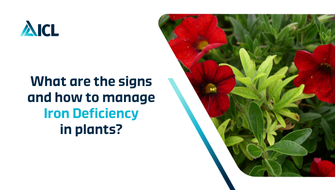Sulphur deficiency is a relatively common nutrient deficiency in horticulture, affecting various plants. Sulphur is an essential element required by plants for various physiological processes, and its deficiency can have several noticeable symptoms, impacts, and management strategies.
What are the symptoms of Sulphur Deficiency?
- Yellowing of Leaves: One of the most common symptoms of sulphur deficiency is the yellowing (chlorosis) of younger leaves. This yellowing typically starts at the tips and edges of the leaves and can progress inward. In severe cases, the entire leaf may turn yellow.
- Stunted Growth: Sulphur deficiency can lead to reduced plant growth and development. Plants may appear smaller and less vigorous compared to healthy plants.
- Delayed Maturity: Sulphur deficiency can delay the flowering and fruiting of plants, affecting their overall reproductive capacity.
- Reduced Nutrient Uptake: Sulphur deficiency can interfere with the plant’s ability to take up other essential nutrients like nitrogen, leading to imbalances in nutrient levels.

Sulphur Deficiency in Pelargonium
What are the impacts of Sulphur Deficiency?
- Reduced Crop Yield: Sulphur deficiency can significantly reduce the yield of horticultural crops, including fruits, vegetables, and ornamental plants.
- Lower Quality Produce: Sulphur deficiency can also impact the quality of fruits and vegetables, leading to smaller fruit size, lower sugar content, and reduced shelf life.
- Increased Susceptibility to Pests and Diseases: Weakened plants are more susceptible to pest infestations and diseases, which can further reduce crop yield and quality.

Sulphur Deficiency in Poinsettia
How should you manage Sulphur Deficiency?
- Soil Testing: Before addressing sulfur deficiency, it’s essential to confirm that it is the cause of the symptoms. Soil testing can help determine if sulfur levels are low in the soil.
- Sulphur Fertilisation: If soil tests indicate low sulfur levels, sulphur-containing fertilisers can be applied to correct the deficiency. Common sulphur-containing fertilisers include ammonium sulfate and elemental sulphur. These should be applied according to recommended rates and timing.
- Organic Matter: Increasing the organic matter content of the soil can help improve sulphur availability over time. Organic matter decomposition releases sulfur into the soil.
- Crop Rotation: Some plants are more sensitive to sulphur deficiency than others. Implementing crop rotation can help manage sulphur levels in the soil by reducing the depletion of sulphur-sensitive crops.
- pH Management: Soil pH can affect sulphur availability. Maintaining the appropriate pH range for your crops can help ensure optimal sulphur uptake.
- Foliar Sprays: In cases of severe deficiency or when a quick response is needed, sulfur can be applied as a foliar spray. This is a temporary solution and should be used in conjunction with soil-based management practices.

Sulphur Deficiency in Poinsettia
It’s important to note that excessive sulphur application can lead to sulfur toxicity and other nutrient imbalances, so it’s crucial to monitor soil nutrient levels and follow recommended guidelines for sulfur application. Regular soil testing and a well-balanced nutrient management plan are essential for preventing and addressing sulphur deficiency in horticulture.
0 Brands found
0 Products found
13 Resources found














